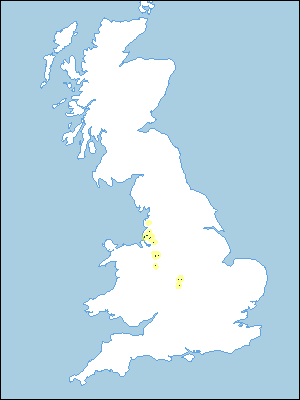
Soil Associations
0711o RUFFORD
Soil and site characteristics
Slowly permeable seasonally waterlogged reddish coarse loamy over clayey soils. Associated with deep sandy soils affected by groundwater some with a bleached subsurface horizon.
Geology
Reddish till and glaciofluvial sand
Cropping and Land Use
Arable cropping, dairying on short term grassland.
Component soil series
| Subgroup | Series name | Percentage | WRB 2006 link |
|---|---|---|---|
| 7.11 | RUFFORD | 55% | Chromic Eutric Luvic Planosols |
| 8.21 | BLACKWOOD | 25% | Arenic Mollic Gleysols |
| 6.41 | SOLLOM | 20% | Endogleyic Albic Carbic Podzols |
Covers 117 km2 in England and Wales
Soilscapes Classification
| 18 |
Slowly permeable seasonally wet slightly acid but base-rich loamy and clayey soils |
0711o RUFFORD
Detailed Description
The Rufford association occurs in Lancashire, Cheshire, Shropshire and Warwickshire where shallow glaciofluvial deposits overlie reddish till. It is found on flat or gently sloping land, at heights between 7 and 75 m O.D. The main soil is the Rufford series, typical stagnogley soils, with coarse loamy upper horizons over reddish clayey till. The Blackwood series, typical sandy gley soils, and the sandy Sollom series, typical gley-podzols, each occupy about one-fifth of the association. The Rufford association has been previously mapped in Cheshire (Furness 1978) and similar soils were described as Astley Hall association in Lancashire (Hall and Folland 1970). Around Ormskirk and south-west of St Helens the soils are formed in the Shirdley Hill Sand overlying till. This aeolian sand varies in depth and locally is greater than 80 cm thick, giving deep sandy soils of the Sollom and Blackwood series. Similarly in Cheshire and Warwickshire where the thickness of glaciofluvial drift is variable pockets of deep sandy loam Arrow and Quorndon series are included. Salwick and Astley Hall series (Beard 1984) are occasionally important associates where slopes are greater than 7° and excess water can be shed laterally downslope through the coarse upper layers. In Cheshire and Warwickshire Salop series is almost always present and locally these heavy soils are dominant. Between Nantwich and Crewe the unit includes occasional clayey Crewe soils developed in stoneless glaciolacustrine deposits.
Soil Water Regime
Because of the flatness of the ground and the slowly permeable subsoil, the Rufford series is seasonally waterlogged (Wetness Class III, where there are less than about 175 field capacity days, and Wetness Class IV where there are more). The waterlogging in the permeable upper horizons can be easily improved by drainage measures but the rate of water movement through the dense clayey subsoil is not easily improved. The sandy Sollom and Blackwood soils with their extremely permeable profiles, are very responsive to drainage measures and will normally be effectively drained (Wetness Class I). Soil variation, often within a single field, however, is such that careful investigation is necessary before drainage is installed. Winter rain is readily absorbed.
Cropping and Land Use
Most of the land is under mixed arable and grassland but in Cheshire grassland predominates, reflecting the importance of dairy farming there. In Lancashire these coarse easily worked soils are mainly in cultivation, especially where adjacent to the Sollom association. Autumn ploughing is essential and, although Rufford soils lie waterlogged during the winter, with careful timing of cultivations they can grow a wide range of crops. The land is never more than slightly droughty in a normal year, since the underlying clay provides a reserve of moisture, enabling growth to continue in dry spells after crops on nearby deep sandy soils have suffered a check. The soils are fertile if nutrient and organic matter levels are maintained.
0711o RUFFORD
Distribution Map
 |
Note that the yellow shading represents a buffer to highlight the location of very small areas of the association.
Keys to component soil series
Midlands
 |
All information Copyright, Cranfield University © 2024
Citation: To use information from this web resource in your work, please cite this as follows:
Cranfield University 2024. The Soils Guide. Available: www.landis.org.uk. Cranfield University, UK. Last accessed 19/04/2024
